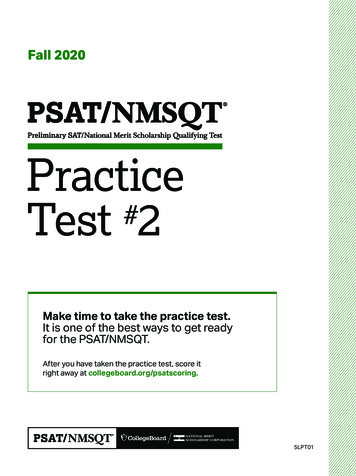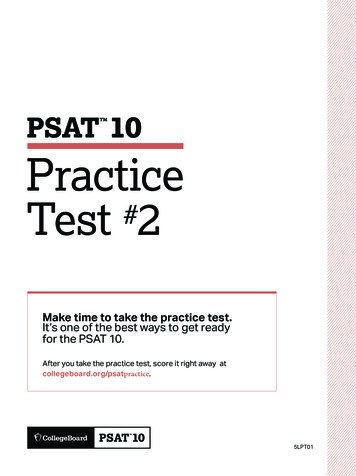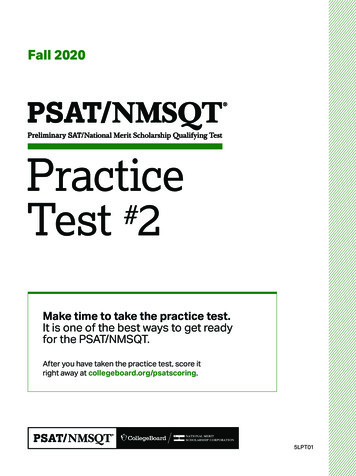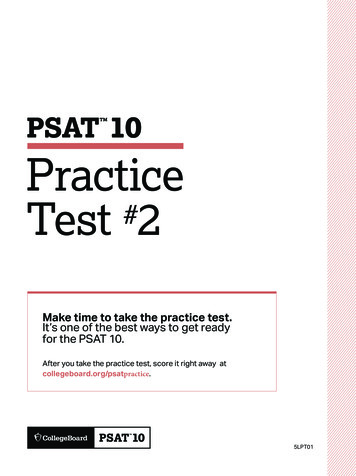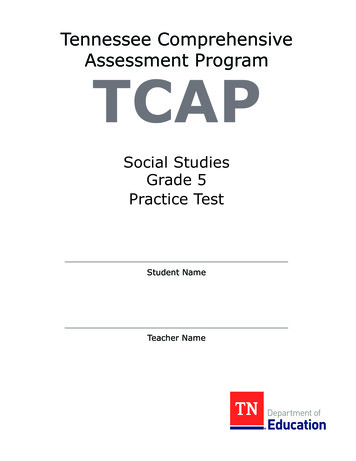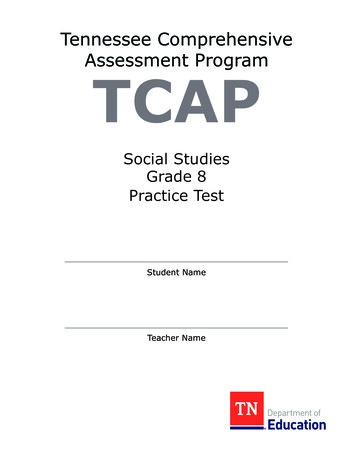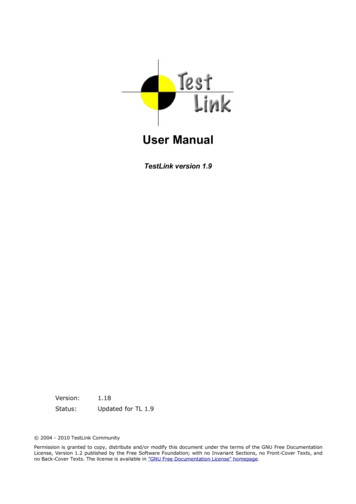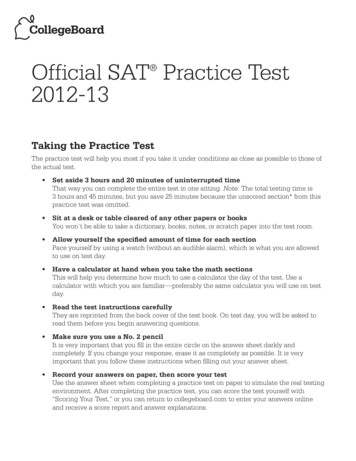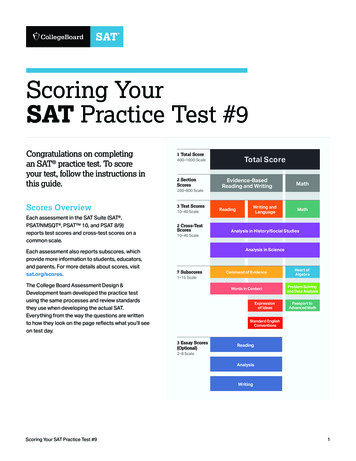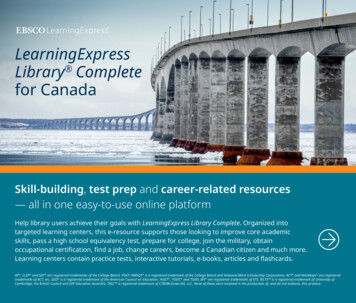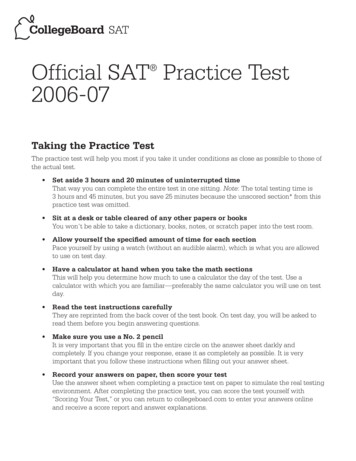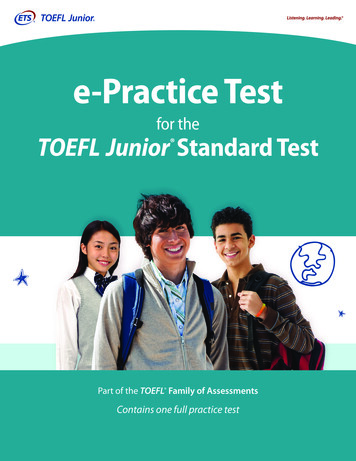
Transcription
e-Practice Testfor theTOEFL Junior Standard Test Part of the TOEFL Family of AssessmentsContains one full practice test
No part of the TOEFL Junior Standard e-Practice Test may be reproduced or transmitted in any form or by any means,electronic or mechanical, including photocopying, recording, or any information storage and retrieval system, without permissionin writing from the publisher. The publisher reserves the right to prosecute violators in accordance with international treaties andthe trademark and copyright laws of the United States and other countries. Direct permission requests to www.ets.org/legal.
Notes to the UserThese TOEFL Junior Standard test practice materials were created by professionaltest developers at ETS. The test questions are an accurate reflection of thequestions found in an actual TOEFL Junior Standard test.The ideas expressed in the reading materials contained in the practice test do notnecessarily reflect the opinions of the TOEFL Board or Educational Testing Service(ETS ).The TOEFL Junior Program does not operate, endorse, or recommend any schoolsor study materials that claim to prepare students for the test in a short time or promisehigh scores. Any use of this practice material by a school or study program does notmean that it has been endorsed by ETS or the TOEFL Junior Program.In order to complete the Listening section of the practice test, you will need to accessthe following website for the audio files: ght 2014 by Educational Testing Service. All rights reserved. ETS, the ETS logo TOEFL and TOEFL JUNIOR are registered trademarks ofEducational Testing Service (ETS) in the United States and other countries. Other trademarks herein are the property of their respective owners.
Table of Contents. . . . . . . . . . . . . . 3What is in the Test? . . . . . . . . . . . . . . . . . . . . . . . . . . . . . . . .Listening Comprehension Section . . . . . . . . . . . . . . . . . .Language Form and Meaning Section . . . . . . . . . . . . . . .Reading Comprehension Section . . . . . . . . . . . . . . . . . . .4445. . . . . . . .Taking the Practice Test . . . . . . . . . . . . . . . . . . . . . . . . . .General Study Tips . . . . . . . . . . . . . . . . . . . . . . . . . . . . . .Here are some tips for improving yourlistening skills . . . . . . . . . . . . . . . . . . . . . . . . . . . . . . .Here are some tips for improving yourlanguage form and meaning skills . . . . . . . . . . . . . . . .Here are some tips for improving yourreading skills . . . . . . . . . . . . . . . . . . . . . . . . . . . . . . . .Use proven test-taking strategies . . . . . . . . . . . . . . . . .6666777Answer Sheet . . . . . . . . . . . . . . . . . . . . . . . . . . . . . . . . . . . . 8Completing Your Answer Sheet . . . . . . . . . . . . . . . . . . . . 8Practice Test Answer Sheets . . . . . . . . . . . . . . . . . . . . . . . 9Practice Test . . . . . . . . . . . . . . . . . . . . . . . . . . . . . . . . . . . .Listening Comprehension Section . . . . . . . . . . . . . . . . .Language Form and Meaning Section . . . . . . . . . . . . . .Reading Comprehension Section . . . . . . . . . . . . . . . . . .13152539Review Materials . . . . . . . . . . . . . . . . . . . . . . . . . . . . . . . . 53Answer Key . . . . . . . . . . . . . . . . . . . . . . . . . . . . . . . . . . . 55Listening Comprehension Script . . . . . . . . . . . . . . . . . . . 57Taking the TOEFL Junior Standard Test . . . . . . . . . . 69
About the TOEFL Junior Standard TestEnglish-language proficiency is an increasingly important skill for students worldwide as it provides access to a widerange of educational, personal and professional opportunities. Reliable assessment of progress in English languagelearning at a young age is crucial for student development.Market research indicates a global need for a well-designed, objective measure of proficiency in English to help youngerstudents, specifically in middle-school grades.Educational Testing Service (ETS) developed the TOEFL Junior Standard test for the English language learningneeds of students in middle-school grades, usually ages 11–15.The TOEFL Junior Standard test measures the degree to which middle-school students have attained proficiency in theacademic and social English language skills representative of English-medium instructional environments. It is not basedon or limited to any specific curriculum. Designed to measure listening comprehension, language form and meaning, andreading comprehension, the test gives schools, teachers, parents, and students an objective measure of the test taker’sEnglish language learning progress. Scores can be used to support decisions to place students into programs designed toincrease English proficiency levels. The test can also be used to measure student progress in developing Englishlanguage proficiency over time.Taking this e-practice test will help you identify any areas where you need improvement. You can use the“General Study Tips” section to help you prepare for the actual test. The practice test will also help you know what toexpect when you take the TOEFL Junior Standard test — you will be familiar with the types of questions and how tomark your answer sheet. You will not receive a final score for the practice test.There are no passing or failing scores set by ETS for the TOEFL Junior Standard test — each school decides for itselfwhat scores are acceptable for its purposes.3
What is in the Test?The questions on the TOEFL Junior Standard test are multiple-choice questions, each with four possible answers.There are three sections, each measuring a critical skill in the use of English. Each section has 42 questions, and totaltesting time is approximately two hours. All questions are placed in the context of a school environment.Listening Comprehension SectionThe Listening Comprehension section measures your ability to listen for instructional, social, and academic purposes.The section contains three different question types, each designed to meet one of these purposes: Classroom Instruction. In this question type, you will listen to a short talk by a teacher, principal, librarian, or otherschool staff member. Each talk lasts 20 to 45 seconds. After the talk you will answer one question. The questionmay ask you to identify the main idea or the purpose of the talk, or make an inference or prediction based on whatthe speaker says. Short Conversation. In this question type, you will listen to a conversation between two students or between astudent and a school staff member, like a teacher or librarian. The conversations last 60–90 seconds. After theconversation, you will answer 3–4 questions. The questions may ask you to identify the main idea or one of theimportant details of the conversation; to make an inference or prediction based on the conversation; to identify whya speaker talks about certain information; or to recognize how a speaker feels or what a speaker means when usingcertain intonation or stressing certain words. Academic Listening. In this question type, you will listen to a classroom lecture or discussion about an academictopic. After you listen, you will answer 4–5 questions. The question may ask you to identify the main idea or oneof the important details of the lecture or discussion; to make an inference or prediction based on the lecture ordiscussion; to identify why a speaker talks about certain information; or to recognize how a speaker feels or what aspeaker means when using certain intonation or stressing certain words.Language Form and Meaning SectionThe Language Form and Meaning section measures your understanding of the structure of English and the depth ofyour vocabulary knowledge. The questions are presented within a series of short paragraphs. Each question requiresyou to choose the correct word or phrase that accurately completes a sentence. Each paragraph represents the kinds ofreading that students do in a school context: Emails, notes, or announcements Short fictional passages Student reports Magazine articles Passages from textbooksThere are two main types of questions. Language Form questions test knowledge of grammatical structures (forexample, verb tenses, relative clauses, word order, adjective or adverb form). Language Meaning questions testknowledge of vocabulary.4
Reading Comprehension SectionThe Reading Comprehension section measures your ability to read and comprehend both academic and non-academictexts that you might come across in a school environment. Examples of non-academic texts include: Correspondence (emails, notes, and letters) Non-linear texts (schedules and menus) News articles (like those found in a school or local newspaper)Examples of academic texts include: Narratives about fictional characters Persuasive texts that support an opinion (letters to the editor and movie or book reviews) Passages about an academic topic that might be found in a textbook or specialized magazineThe questions in the Reading Comprehension section test your ability to: Comprehend the main idea of a text Identify important factual information that supports the main idea Make inferences based on what is not explicitly stated in a text Determine the meaning of unfamiliar words or expressions from context Identify the words that pronouns represent Recognize an author’s purpose5
Preparing for the TOEFL Junior Standard TestTaking the Practice TestTaking the practice test in this book will give you a good idea of what the actual test is like in terms of the typesof questions you will be asked and the time limits you will have. You will have 40 minutes to complete theListening section, 25 minutes to complete the Language Form and Meaning section, and 50 minutes to completethe Reading section.Each section begins with a set of special directions that includes sample questions and answers. It is important to readthese directions so you will understand exactly what you are to do before you start to work on a section.Some questions may be harder than others, but try to answer every one. If you are not sure of the correct answer,make the best guess you can and go on to the next question. It is to your advantage to answer every question, even ifyou have to guess. There is no penalty for guessing.As you take the practice test, work rapidly but carefully. Do not spend too much time on any single question. You maytake notes only during the Listening section.Here are more guidelines for using the practice test: Plan to spend approximately two hours without interruption to take the practice test Choose a quiet room in which to work Use a stopwatch or a clock so you can know the correct amount of time Have two sharpened No. 2 or HB black lead pencils and an eraser Remove any study materials from your work areaGeneral Study TipsHere are some tips for improving your listening skills: Watching English-language movies and television programs and listening to English-language radio provideexcellent opportunities to build your listening skills. English-language recordings are equally valuable and helpful.The Internet is also a great resource for material that you can use to improve your English listening skills. Listen carefully to what the speaker is saying. Stay active by asking yourself questions. For example, what main idea is the speaker communicating? Think about what the speaker is doing. In other words, what is the purpose of the speech or conversation? Forexample, is the speaker apologizing, complaining, or making suggestions? Is the speaker’s voice calm or emotional? What does the speaker’s tone of voice tell you? Pay careful attention to the way stress and intonation patterns are used to convey meaning. Think about how a talk or discussion is organized. Listen for signal words that indicate the introduction, majorsteps or ideas, examples, and the conclusion or summary. Listen for words that show connections and relationships between ideas (for example, “because,” “however,”“therefore”). Listen to recorded material and stop the recording at various points. Predict what information or idea will beexpressed next. During or after the lecture, create an outline of the information discussed.6
Here are some tips for improving your language form and meaning skills: Read a text first for meaning. Then, review the same text, this time paying attention to the different ways thesentences are structured. In each of the sentences, determine the part of speech that each word represents. Try to identify thesubject, verb, object, adjectives, adverbs, prepositions, determiners, and conjunctions. Also, try toidentify the verb tense. Find out how other parts of the sentence are related to the main clause by looking for structural cluessuch as connectors or punctuation marks. Look for transitional words such as “because,” “however,” and “therefore.” Pay attention to how thesewords connect ideas across sentences. Increase your vocabulary, learning 6 or 7 new words every day. Keep a growing list of words and review the entirelist from time to time to make sure you do not forget the meanings of the words. Keep an English-language journal. Spend a few minutes every day writing in your journal. If you are taking English classes at school and learning grammar, make a point of using newgrammatical structures you have learned when you write. Once you have completed an entry, make sure to go back and re-read what you have written. Revision isthe key to improving writing. Correct any errors that you find. Highlight areas you are unsure about andask questions about them in class.Here are some tips for improving your reading skills: Read a few pages in English every day. Read a variety of English-language texts, including short stories,newspaper and magazine articles, and non-fiction texts about academic topics such as science, social studies, andarts. Many such texts can be found on the Internet. Practice skimming a passage quickly to get the main idea. Develop the ability to skim quickly and identifymajor points. After skimming a passage, read it again more carefully and write down the main idea, major points andimportant facts. When you come across an unfamiliar word, try to determine the meaning from the context. If you cannot determinethe meaning from context, look up the meaning of the word in a dictionary. Underline all pronouns (he, him, they, them, etc.) and identify the nouns to which they refer in the passage.Use proven test-taking strategies Carefully follow directions in each section of the test to avoid wasting time. Don’t panic. Concentrate exclusively on the current question only. Don’t think about how you answered otherquestions. This is a habit that can be learned through practice. Avoid spending too much time on any single question. If you have given the question some thought and you stilldon’t know the answer, eliminate as many choices as possible and then select the best choice.7
Answer SheetCompleting Your Answer SheetWhen you mark your answers on the answer sheet: Use a No. 2 or HB black lead pencil. Mark only one answer to each question. Be sure to mark your answer in the row with the same number as the question you are answering. Carefully and completely fill in the circle corresponding to the answer you choose for each question. If you changeyour mind about an answer after you have marked it on your answer sheet, completely erase your old answer andthen mark your new answer.Taking the practice test: Remove one of the sample answer sheets from this book. Leave this book open to page 15. Place the book and the answer sheet in front of you. For the audio files to the practice test, you will need to access the following st. Play the audio file from your computer. The test narrator willtell you what to do. You will have 12 seconds to answer each Listening question. The narrator will move on to the next question after12 seconds. Do not spend too much time trying to answer one Listening question. The Listening section ends after the narrator asks the last question. When you have finished the Listening section,set your timer for 25 minutes and begin the Language Form and Meaning section. You have only 25 minutes to answer 42 questions in this section, so work efficiently. Do not spend too much timeon any one question. When 25 minutes have passed, stop working on the Language Form and Meaning section. (If you did not answerall of the questions, you can review the ones you skipped when you’ve finished the practice test.) Set your timer for50 minutes and begin the Reading section. You have 50 minutes to answer 42 Reading questions. Reading the passages will take up most of your time, so payattention to the time as you read the passages and answer the questions. When 50 minutes have passed, stop working on the Reading section. You have now finished the test. Turn to page 55 in this book to review your answers. Make a note of any incorrect answers and go back to the testto find out why you answered incorrectly. (You can find the scripts for the Listening items on page 57.) If you did not have time to answer all of the Language Form and Meaning or Reading questions, go back and try toanswer those questions now.8
Practice Test Answer NCORRECTDABCADABCADBCLISTENING COMPREHENSIONSAMPLESAABCD7ABCD16 ABCD25 ABCD34 ABCDBABCD8ABCD17 ABCD26 ABCD35 ABCD9ABCD18 ABCD27 ABCD36 ABCD1ABCD10 ABCD19 ABCD28 ABCD37 ABCD2ABCD11 ABCD20 ABCD29 ABCD38 ABCD3ABCD12 ABCD21 ABCD30 ABCD39 ABCD4ABCD13 ABCD22 ABCD31 ABCD40 ABCD5ABCD14 ABCD23 ABCD32 ABCD41 ABCD6ABCD15 ABCD24 ABCD33 ABCD42 ABCDLANGUAGE FORM AND MEANINGTear here to detachSAMPLESAABCD7ABCD16 ABCD25 ABCD34 ABCDBABCD8ABCD17 ABCD26 ABCD35 ABCD9ABCD18 ABCD27 ABCD36 ABCD1ABCD10 ABCD19 ABCD28 ABCD37 ABCD2ABCD11 ABCD20 ABCD29 ABCD38 ABCD3ABCD12 ABCD21 ABCD30 ABCD39 ABCD4ABCD13 ABCD22 ABCD31 ABCD40 ABCD5ABCD14 ABCD23 ABCD32 ABCD41 ABCD6ABCD15 ABCD24 ABCD33 ABCD42 ABCDREADING COMPREHENSIONSAMPLESAABCD7ABCD16 ABCD25 ABCD34 ABCDBABCD8ABCD17 ABCD26 ABCD35 ABCD9ABCD18 ABCD27 ABCD36 ABCD1ABCD10 ABCD19 ABCD28 ABCD37 ABCD2ABCD11 ABCD20 ABCD29 ABCD38 ABCD3ABCD12 ABCD21 ABCD30 ABCD39 ABCD4ABCD13 ABCD22 ABCD31 ABCD40 ABCD5ABCD14 ABCD23 ABCD32 ABCD41 ABCD6ABCD15 ABCD24 ABCD33 ABCD42 ABCD9DBCD
Practice Test Answer NCORRECTDABCADABCADBCLISTENING COMPREHENSIONSAMPLESAABCD7ABCD16 ABCD25 ABCD34 ABCDBABCD8ABCD17 ABCD26 ABCD35 ABCD9ABCD18 ABCD27 ABCD36 ABCD1ABCD10 ABCD19 ABCD28 ABCD37 ABCD2ABCD11 ABCD20 ABCD29 ABCD38 ABCD3ABCD12 ABCD21 ABCD30 ABCD39 ABCD4ABCD13 ABCD22 ABCD31 ABCD40 ABCD5ABCD14 ABCD23 ABCD32 ABCD41 ABCD6ABCD15 ABCD24 ABCD33 ABCD42 ABCDLANGUAGE FORM AND MEANINGTear here to detachSAMPLESAABCD7ABCD16 ABCD25 ABCD34 ABCDBABCD8ABCD17 ABCD26 ABCD35 ABCD9ABCD18 ABCD27 ABCD36 ABCD1ABCD10 ABCD19 ABCD28 ABCD37 ABCD2ABCD11 ABCD20 ABCD29 ABCD38 ABCD3ABCD12 ABCD21 ABCD30 ABCD39 ABCD4ABCD13 ABCD22 ABCD31 ABCD40 ABCD5ABCD14 ABCD23 ABCD32 ABCD41 ABCD6ABCD15 ABCD24 ABCD33 ABCD42 ABCDREADING COMPREHENSIONSAMPLESAABCD7ABCD16 ABCD25 ABCD34 ABCDBABCD8ABCD17 ABCD26 ABCD35 ABCD9ABCD18 ABCD27 ABCD36 ABCD1ABCD10 ABCD19 ABCD28 ABCD37 ABCD2ABCD11 ABCD20 ABCD29 ABCD38 ABCD3ABCD12 ABCD21 ABCD30 ABCD39 ABCD4ABCD13 ABCD22 ABCD31 ABCD40 ABCD5ABCD14 ABCD23 ABCD32 ABCD41 ABCD6ABCD15 ABCD24 ABCD33 ABCD42 ABCD11DBCD
Practice Test
NO TEST MATERIAL ON THIS PAGE
Listening ComprehensionThe Listening section has 42 questions. Follow along as you listen to the directions to the listening section.In this section of the test, you will hear a teacher or other school staff member talking to students.Each talk is followed by one question. Choose the best answer to each question and mark the letterof the correct answer on your answer sheet. You will hear each talk only one time.Here is an example:What does the teacher want the students to do?共A兲共B兲共C兲共D兲Help a new classmatePrepare for gym classWelcome a guest speakerReturn books to the libraryThe correct answer is 共A兲, “Help a new classmate.”Here is another example:What will the students probably do next?共A兲共B兲共C兲共D兲Sing a songListen to some musicChoose instruments to playDiscuss the life of a musicianThe correct answer is 共B兲, “Listen to some music.”Go on to the next page, and the test will begin with question number one.15
4. What is probably true about thestudents’ parents?1. What will the students probably donext?共A兲 They want to place their children inanother class.共B兲 They have been asking about thestudents’ grades.共C兲 They have reminded their children toattend a conference.共D兲 They haven’t scheduled conferenceswith the teacher.共A兲 Clean up a mess in the laboratory共B兲 Ask the teacher some questions共C兲 Present reports about a scienceexperiment共D兲 Put on safety glasses2. What is the purpose of the talk?共A兲 To explain to students why debating isimportant共B兲 To describe to students the process forthe class debates共C兲 To discuss ways students can improvetheir classroom debates共D兲 To find out if students would beinterested in starting a debate team5. What does the teacher want thestudents to do?共A兲 Take everything out of their desks共B兲 Put the painting supplies in plasticbags共C兲 Bring paints with them to school onMonday共D兲 Put covers on their desks to keep thepaint off3. What did the principal like best aboutthe band?共A兲 The students wrote their own music.共B兲 The band played several kinds ofmusic.共C兲 The band played during the wholefestival.共D兲 The students played many differentinstruments.6. What is the purpose of theannouncement?共A兲 To remind students about a visit by aguest speaker共B兲 To inform students that lunch will beearly today共C兲 To inform students about a trip to alocal university共D兲 To remind students to keep quietduring a performance16
9. What is probably true about thestudents?7. What does the teacher say about theplants in the photographs?共A兲 They are starting to learn about a newtopic.共B兲 They are not good at drawing shapes.共C兲 They have new pencils and rulers.共D兲 They have been studying shapes.共A兲 They can be harmful.共B兲 They are used in medicines.共C兲 They are difficult to identify.共D兲 They no longer grow in the area.8. Why does the principal apologize?10. What is the purpose of the talk?共A兲 The students will have to use the oldtables and chairs in the new cafeteria.共B兲 The students will have to wait beforethey can eat in the new cafeteria.共C兲 The cafeteria will be using the samemenu as last year.共D兲 The students will have a shortenedvacation this year.共A兲 To tell students about the library’shours and policies共B兲 To persuade students to use booksinstead of computers共C兲 To give students information about thelibrary’s research tools共D兲 To warn students about unreliableinformation on the Internet17
13. What will the boy and girl probably donext?11. What is the boy’s problem?共A兲 He forgot a phone number.共B兲 His mobile phone is broken.共C兲 He cannot find his mobile phone.共D兲 He left his mobile phone at home.共A兲 Call a friend共B兲 Make some signs共C兲 Phone the boy’s house共D兲 Write down a list of phone numbers12. What does the boy say his teachermakes the class do?共A兲 Turn off their mobile phones共B兲 Leave their mobile phones at home共C兲 Put their mobile phones inside theirdesks共D兲 Keep their mobile phones in theirbackpacks18
16. What caused plans to change duringthe trip to the mountains?14. Where is the conversation probablytaking place?共A兲 A student got hurt.共B兲 It was snowing in the mountains.共C兲 A path on the mountain was closed.共D兲 The students were too tired to climb tothe top.共A兲 On a bus共B兲 At a restaurant共C兲 In the mountains共D兲 In a school hallway15. Why is the boy surprised?17. What does the girl suggest about thefood on the trip?共A兲 He did not think he could hike far.共B兲 He thought it would be a rainy day.共C兲 He did not expect to see the girl today.共D兲 He thought he was going to be late forclass.共A兲 It did not taste good.共B兲 There was not enough to eat.共C兲 It was prepared before the trip.共D兲 The students enjoyed making it.19
20. Where does the boy say he may go thisweekend?18. What are the speakers mainlydiscussing?共A兲 To the zoo共B兲 To an art store共C兲 To Main Street共D兲 To the public library共A兲 A new art project in the city共B兲 An assignment for their art class共C兲 An art display inside the public library共D兲 A painting that the girl saw downtown21. Why does the girl suggest that the boygo to the art room?19. Why is the boy excited?共A兲 A famous artist is going to visit hisclass.共B兲 His artwork might be seen by manypeople.共C兲 His class might visit an art museum.共D兲 He is getting a good grade in his artclass.共A兲 So that he can hand in his homework共B兲 So that he can sign up for a class trip共C兲 So that he can see a new painting共D兲 So that he can talk to the teacher20
24. What does the boy say about hisuncle?22. What is the girl’s problem?共A兲 She cannot find her report.共B兲 The library is closed today.共C兲 She is late in handing in anassignment.共D兲 The book she has is damaged.共A兲 He is very wealthy.共B兲 He is a famous writer.共C兲 He used to work in a library.共D兲 He has many books on architecture.25. What will the girl probably do afterschool?23. How does the girl probably feel whenshe says, “Wow! Do you think he’ll letme borrow it?”共A兲 Study for a test with her friends共B兲 Go with the boy to meet his uncle共C兲 Go to the library to write her report共D兲 Ask her teacher for extra time on anassignment共A兲 Excited共B兲 Nervous共C兲 Upset共D兲 Uncertain21
28. What does the speaker imply about thefood that camels eat?26. What is the main topic of the talk?共A兲 Places where camels look for food inthe desert共B兲 How camels survive in the desert共C兲 New kinds of foods discovered in thedesert共D兲 Why temperatures change quickly inthe desert共A兲 It is full of fat.共B兲 It dries out quickly.共C兲 It is difficult to find.共D兲 It contains a lot of water.29. According to the speaker, what isharmful to most animals’ health?27. What false belief about camels does thespeaker correct?共A兲 Drinking too much water共B兲 Eating food that is very old共C兲 Going too long without rest共D兲 Spending a lot of time in the sun共A兲 That they run very fast共B兲 That they are found only in hotregions共C兲 That they can easily find water in thedesert共D兲 That they store water in their humps22
32. According to the teacher, what mustpilots do before a balloon flight?30. What are the teacher and studentmainly talking about?共A兲 Check weather reports共B兲 Find out about other air traffic共C兲 Follow instructions from someone onthe ground共D兲 Choose the right balloon for theconditions共A兲 Learning how to pilot a balloon共B兲 Breaking records in balloon flights共C兲 Problems related to flying by balloon共D兲 Different kinds of balloons used fortransportation31. What event does the girl mention?33. What can be inferred from theconversation about using balloons fortransportation?共A兲 A ballooning course共B兲 A ballooning contest共C兲 A museum exhibit about ballooning共D兲 A television program about ballooning共A兲 Balloons will probably be used fortransportation more in the future.共B兲 Balloons are unable to fly far enoughto be useful for transportation.共C兲 Balloons are too difficult to control tobe used for transportation.共D兲 Balloons cost too much money to beused for transportation today.23
36. According to the teacher, what is oneactivity that both leaf-cutter ants andpeople do?34. What is the main topic of the talk?共A兲 A newly discovered type of ant共B兲 A type of ant with unusual skills共C兲 An increase in the population of onetype of ant共D兲 A type of ant that could be dangerousto humans共A兲 Clean their food共B兲 Grow their own food共C兲 Eat several times a day共D兲 Feed their young special food37. What did the experiments show aboutleaf-cutter ants?35. What does the teacher say manypeople think must be true aboutleaf-cutter ants?共A兲 How fast they grow共B兲 Which plants they eat共C兲 Where they look for leaves共D兲 How much weight they can carry共A兲 They eat leaves.共B兲 They live in plants.共C兲 They have sharp teeth.共D兲 They are especially large.24
41. What led to the establishment ofprivate postal systems during theRenaissance?38. What is the main topic of the talk?共A兲 The influence of the Roman Empireon businesses共B兲 Improvements in electronic mailservices共C兲 Ways postal services have changedover time共D兲 Reasons that most people do not sendpaper documents共A兲 An increase in international business共B兲 Growing numbers of people whocould read and write共C兲 Advances in printing technology共D兲 Changes in land ownership laws42. What does the teacher imply when hesays, “Of course, with today’stechnology, there may soon be no needfor any of them”?39. What does the teacher suggest aboutthe early mail carriers who rode onhorses?共A兲 Governments and private postalcompanies will probably use computersmore in the future.共B兲 Modern technology is makinginternational mail delivery moreefficient.共C兲 Most people prefer to communicate byphone rather than by e-mail.共D兲 People will use only computers forlong-distance communication in thefuture.共A兲 They were highly respected by peopleat the time.共B兲 They often took a piece of mail onlypart of the way.共C兲 They usually traveled with soldiers forprotection.共D兲 They had to pass a physical test to getthe job.40. What happened to the Roman mailsystem when the Roman Empireended?共A兲 It was taken over by a privatebusiness.共B兲 The Romans destroyed most of it.共C兲 It continued to be used for a period oftime.共D兲 Countries fought to manage it.25
NO TEST MATERIAL ON THIS PAGE26
Language Form and MeaningIn this section of the test, you will answer 42 questions found in seven different texts. Within eachtext are boxes that contain four possible ways to complete a sentence. Choose the word or words ineach box that correctly complete each sentence. Mark the letter of the correct ans
Table of Contents About the TOEFL Junior Standard Test . . . . . . . . . . . . . 3 What is in the Test .
